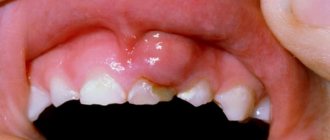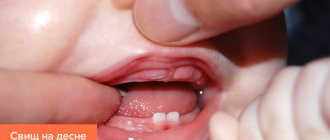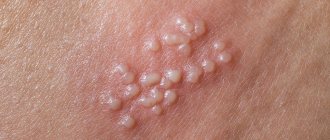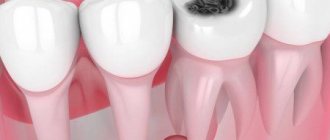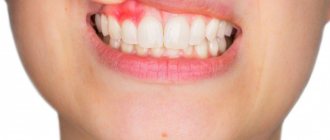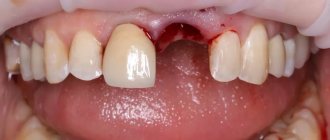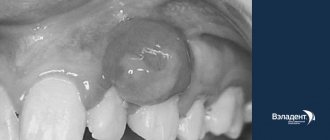Stomatitis of various etiologies
The oral mucosa becomes inflamed with stomatitis. Whitish spots are located on the inner sides of the cheeks, on the gum tissue. Without therapeutic measures, painful ulcers will quickly appear. Such children exhibit restless behavior, fever, loss of appetite, and disturbed sleep. The disease may be:
- Viral, when it occurs against the background of influenza, chickenpox, bronchitis and other diseases;
- Allergic, if the baby develops asthma, atopic dermatitis appears;
- Bacterial, when the little one picks up some kind of infection, for example, a fungal one;
Purulent cyst
A white spot on a child's gum may indicate the development of cysts. They look like beads. Occurs against the background of infection of the body. A formation with purulent contents is detected on x-ray. Most often, the disease is caused by bacteria that penetrate into the chewing organs or soft tissues. This happens with complicated caries. When the accumulated pus begins to come out, swelling appears. If you do not visit the pediatric dentist on time, the pus accumulates, then the abscess breaks out, and the little one develops a fistula. Don't ignore rashes in your child's mouth! Contact your doctor promptly!
Lipoma and leukoplakia
With leukoplakia, keratinization of the mucous membrane is noted. This process is influenced by the following stimuli:
- sharp edges of affected teeth;
- hanging uneven fillings;
- hot and spicy food;
- malocclusion;
- improperly fitted dentures;
- crowns made of various materials;
With this disease, whitish plaques may have clearly defined edges or blurred ones. There is no discomfort. The rash may be rough, cracks and ulcers may appear. The doctor will take a sample of this tissue to send for a biopsy. Often the formation turns out to be a harmless lipoma, that is, a wen. It requires medical supervision. It is important that its size does not increase.
What is epulis
A tumor on the gum is characterized by a benign nature. It is classified as a group of periodontal diseases. Epulis is also called “giant cell granuloma” or “supragingival”. Epulis looks like a lump that is attached to the gum in the area of the interdental space on a stalk. A formation is formed from the epithelium of the alveolar process.
In diameter, an epithelial tumor of the gums can reach a size of more than 3 cm. The shade of a giant cell granuloma can be different: bluish, brown, red-brown, or the color of the gums. Ulcers may appear in the affected area.
If the epulis on the gum has a diameter of up to 2 cm, does not cause pronounced symptoms and progresses slowly, then the pathology is classified as a benign form. With rapid growth of the supragingival tissue, severe pain, inflammation and swelling of the gums, there is a risk of developing a malignant tumor.
According to statistics, the pathology is most often diagnosed in pregnant women, but supragingival formation also occurs in women who are not pregnant. Less commonly, the disease occurs in men and young children when replacing milk teeth with permanent ones.
What reasons can lead to its appearance?
The main cause of epulis on the gums is considered to be constant mechanical impact (rubbing) of soft tissues.
Injury to one area can cause gum swelling:
- poorly installed seal;
- uneven edges of the opposite tooth, which is destroyed or chipped;
- tartar;
- poor quality or incorrectly installed prosthesis;
- agonist tooth for malocclusion;
- adjacent teeth when teeth “pile up.”
Supragingival tissue occurs and, as a consequence, injury to epithelial tissue as a result of a burn, bruise or constant ingestion of irritating foods. In pregnant women, tumors occur due to hormonal imbalances. Epulis on a child’s gums can form due to general causes or disturbances in the eruption of permanent teeth.
Prevention
To prevent the occurrence of pathology, preventive measures should be taken.
- The baby’s mouth should be cleaned after any meal and rinsed with boiled water.
- Mother and child should eat a balanced diet.
- It is necessary to protect the baby from kissing people who have sore gums, from traumatic games, and from chewing objects with sharp edges.
- Pacifiers, toys, bottles should be perfectly clean, like the hands of a toddler.
- See your dentist regularly for preventative checkups.
- The baby must use a separate towel and utensils.
Types of epulis
Depending on the nature of the pathological process, epulis on the gums is divided into three main types.
- Fibrous. The gum tumor differs in density. Its base is coarse fiber fabric. The tumor grows slowly and asymptomatically.
- Angiomatous. Epulis angiomatous consist of epithelial cells and a large number of blood vessels. The tumor is localized mainly in the molar area. Due to the many blood vessels, even with a slight impact on the tumor, bleeding occurs. On palpation, the lump is soft and painful.
- Giant cell. The tumor formation can be large. Giant cell epulis affects the position of teeth, displacing them. Pain is not typical for this species, but bleeding is possible due to mechanical damage.
The development of giant cell epulis on the gum poses the greatest risk, since the likelihood of the tumor becoming malignant is much higher than with other forms of the disease.
Complications
In the absence of timely and high-quality treatment, the disease can cause serious complications. A frequent consequence of suppuration during periodontitis is periodontal disease, a disease characterized by the formation of very deep gum pockets and the spread of foci of infection and suppuration throughout the gums. Over a long period of time, periodontal disease usually leads to loosening of teeth and their loss. In addition, inflammation can lead to the formation of gumboil, a large abscess that causes the gums and cheek to swell and lose their natural shape. Treatment for flux usually requires surgery.
The presence of a constant source of infection in the body negatively affects the functioning of all organs and systems, in particular the functioning of the immune system. Abscesses and other chronic infectious diseases lead to a steady decrease in immune status, which creates favorable conditions for the development of a whole range of diseases.
We should not forget that the muscles and nerves of the face are located in close proximity to the gums. For example, the formation of a large abscess on the gingival part of the upper jaw can lead to damage to the trigeminal nerve, which innervates the nasolabial triangle. Sharp pain of a neurogenic nature, paresis and paralysis of the facial muscles are rare, but still probable consequences of gingival abscesses.
What to do with it: remove or treat
Epulis on the gums is considered a serious pathology that requires specialist help as early as possible. Delaying a visit to the doctor can cause complications. What treatment will be carried out depends on the type of disease and clinical picture.
Treatment always begins with identifying and eliminating the provoking factor. If the cause lies in internal processes, then therapy is carried out simultaneously with the treatment of epulis. When a tumor is caused by orthopedic or orthodontic structures, tooth damage, poor-quality restoration, etc., the cause is first eliminated. Professional teeth cleaning using a gentle method is mandatory. The dentist may prescribe the use of local antiseptics, hormonal drugs, antibiotics and other types of medications depending on the cause of the pathology.
In most cases, angiomatous and fibromatous epulis of the gums can be cured conservatively. After the causes of the pathology are eliminated, the tumor may begin to decrease in size and even disappear completely. Giant cell epulis is an indication for surgical treatment.
Removal of epulis on the gum
The need to remove the supragingival tissue occurs when the tumor is large, is growing rapidly, or is at risk of cancer. The procedure is complex and can only be performed by an experienced oral or maxillofacial surgeon.
Removal of epulis on the gum takes place under local anesthesia or sedation. The essence of the operation is to remove the lump and excise the affected tissue. Excision of the epulis itself can be done with a scalpel or laser. Dentists prefer a laser that can instantly stop bleeding and make precise “cuts.”
If the pathological process has penetrated deeply, it is possible to remove a section of bone using a cutter or bur. If teeth are damaged in the area where the tumor is located (loose teeth, exposed roots, etc.), the surgeon removes these teeth as well.
After the operation, the patient is covered with iodomorphic gauze. If there is a large area of dissection, the surgeon will apply sutures. A sterile bandage is applied over it.
In case of angiomatous and fibromatous appearance, removal of epulis on the gum can also be carried out if conservative therapy has not yielded results or the patient seeks help in the presence of complications.
Dentists' recommendations
Epulis is a gum tumor that poses a great danger to the health of teeth and the entire body. Treatment of the pathology is complex and lengthy, but even with high-quality treatment, the risk of relapse cannot be ruled out.
It is not always possible to prevent the occurrence of epulis on the gums of a child or an adult, but with timely consultation with a specialist, complications, complex treatment, long recovery and aesthetic defects that remain after surgery can be avoided.
The best prevention is to visit the dentist every 6 months. If you are concerned about discomfort and a feeling of rubbing of the mucous membranes or gums, you should immediately consult a dentist, without waiting for a tumor or other pathologies to occur.
Types of acne on the gums of a child
You can determine the type of pimple on the gum by examining its surface, as well as by its color. The presence of an inflammatory “corolla” and pain when touched are taken into account.
In addition to local manifestations, it is important to pay attention to the child’s condition and mood. If the child is already 5 years old, you need to interview him and find out his complaints. If a pimple causes discomfort in children, then visually they will look whiny and irritable. Temperature data play a significant role in the diagnosis of complicated or uncomplicated neoplasm.
| Type of pimple | Clinical manifestation | Main disease |
| Wen or lipoma | Painless, soft-consistency growth on the gums | An independent disease, sometimes due to hormonal imbalance |
| Purulent pimple in a child | Painful formation with yellow or light yellow contents | A consequence of poor oral care or as a complication of inflammatory diseases: gingivitis, stomatitis |
| Multiple white pimples | Painful or painless growths on the gums (on the cheeks), white | Human herpes virus or manifestation of stomatitis, gingivitis |
| Cyst | Painful, large, soft pimple on the gum above the tooth | Complications of colds and infections |
| Fistula and phlegmon | Painful formation with discharge of pus. Characteristic foul odor from the mouth. | Complication of inflammatory diseases (stomatitis, gingivitis) |
| Leukoplakia | Damage to the gums, cheeks and tongue, with the formation of white, painless growths. | – |
| White pimples in newborns | Painless | A consequence of early eruption of baby teeth in babies in the first 2–3 months of life. |
White bumps on the gums
Small white pimples located close to each other are the main sign of an infectious disease - human herpes virus or stomatitis .
If such a “rash” is detected on a child’s gums, you should immediately seek medical help. Children are usually calm and it is sometimes difficult to diagnose an infection at an early stage, so you need to examine the oral mucosa daily.
Treatment involves the prescription of antiviral and anti-inflammatory drugs.
Sometimes there is a single painless white pimple on the gum - it could be a wen or a manifestation of dysbacteriosis.
Wen
If parents find a large pimple on the child’s gum that is white, soft in consistency, and painless, then we are talking about a wen.
This is, in fact, a harmless formation only if it does not increase in size over the subsequent time. If there is a pattern of progressive or sluggish growth, only then are parents and their child advised to visit a doctor.
If there is no growth, the main task is to monitor the wen and prevent its future growth.
Herpes
The presence of white bumps in a child's mouth may indicate the development of herpes. Such pimples have cloudy contents. Often, the general condition of the child (babies) worsens: fever, malaise, chills, and loss of appetite increase. If they are identified, there is a reason to worry about possible complications and consult a dentist as early as possible.
Treatment is aimed at combating the pathogen and relieving inflammation.
Stomatitis
Similar to the manifestation of herpes, stomatitis occurs. As with herpes, the main sign will be a white pimple in the mouth on the gum. Their number varies - from one to several nearby. The presence of an inflammatory reaction is a guarantee of restless behavior of the child due to soreness in the mouth.
Therapeutic measures for stomatitis are aimed at eliminating inflammation and relieving pain.
Purulent pimple on the gum
The appearance of a purulent pimple in a child is dangerous to his health. A terrible complication of such an abscess is the breakthrough of its contents not outward, but into the gum tissue. Subsequently, intoxication syndrome increases - a sign of the pathogen entering the bloodstream, since the gums are well supplied with blood. In the presence of this syndrome, body temperature will rise, general malaise and chills will appear. Kids become restless.
Reasons for the development of purulent pimple:
- complications of stomatitis, gingivitis, herpes – more often;
- reduced immunity in children;
- poor oral care;
- gum injuries (in babies and newborns, when they carry everything to the mouth) or manipulations performed the day before (at the dentist);
- with concomitant pathology (allergy, reduced immunity, helminthic infestation).
Possible complications of an abscess:
- cyst;
- fistula or phlegmon.
Cyst
Flux in a child
Cyst is a voluminous formation, with purulent contents, with an inflammatory “rim” around and painful on palpation, of a soft consistency. The cyst does not grow and no release of pus to the surface of the oral mucosa is observed. Initially, redness of the gums appears, accompanied by soreness in the mouth.
The outcome is dangerous for the child’s health:
- breakthrough of pus into the gum tissue, causing periodontitis and general intoxication;
- with independent opening (which is contraindicated!) – the formation of a fistula (an open channel with purulent contents and messages).
Gum inflammation
Inflammation of the gums (gingivitis) is a common complication of purulent acne. External signs of gingivitis in children are irritability and tearfulness. Teenagers will complain of soreness in the mouth, which gets worse when the affected gum is touched. It develops as a result of the breakthrough of pus from a formation (for example, a cyst) into the underlying tissue.
Physiological pimples
Such pimples are often found in newborns. They are painless and do not cause any complications. Parents, when identifying such growths, should not worry, because they resolve on their own, without outside intervention.
Common causes of the development of physiological formations in the oral cavity in children:
- An accumulation of residual epithelium in the oral cavity, collected by the newborn as it passes through the mother's birth canal.
- Hormonal imbalance in the baby’s body (usually at 2–3 weeks of development). The rash will appear not only on the gums, but also on the entire surface of the body.
- Oral candidiasis in children (curdled growths on the gums).
- The result of breastfeeding in newborns (white plaque in the mouth).
- Neonatal tooth (early teething).
